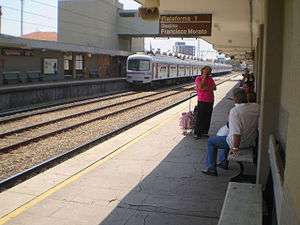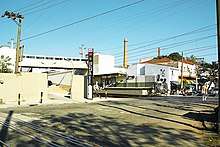Água Branca (CPTM)
Água Branca is a train station on CPTM Line 7-Ruby, in the district of Água Branca in São Paulo. In the future, it will be connected with São Paulo Metro/Move São Paulo Line 6-Orange andCPTM Line 8-Diamond and Regional Trains (Americana↔Santos and Sorocaba↔Pindamonhangaba).[1][2]
 Seties 1100 aligning with the platform towards Luz. | |||||||||||||
| Location | Av. Santa Marina, s/n Água Branca Brazil | ||||||||||||
| Owned by | |||||||||||||
| Operated by | |||||||||||||
| Platforms | Side platforms | ||||||||||||
| Connections | |||||||||||||
| Construction | |||||||||||||
| Structure type | At-grade | ||||||||||||
| Other information | |||||||||||||
| Station code | ABR | ||||||||||||
| History | |||||||||||||
| Opened | 4 April 1891 | ||||||||||||
| Services | |||||||||||||
| |||||||||||||
| |||||||||||||
Track layout | |||||||||||||||||||||||||||||||||||||||||||||||||||||||||||||||
|---|---|---|---|---|---|---|---|---|---|---|---|---|---|---|---|---|---|---|---|---|---|---|---|---|---|---|---|---|---|---|---|---|---|---|---|---|---|---|---|---|---|---|---|---|---|---|---|---|---|---|---|---|---|---|---|---|---|---|---|---|---|---|---|
| |||||||||||||||||||||||||||||||||||||||||||||||||||||||||||||||
History

Água Branca station was one of the opened in the opening of Santos-Jundiaí railway by São Paulo Railway, on 14 February 1867. Initially, it was a rustic building.[3] With the opening of Sorocaba Railway, which was parallel to it, Água Branca station, which was far from São Paulo, began to have importance as an integration point and cargo depot between both railways. In 1896, Vidraria Santa Marina was risen next to the station, which contributed for the industrialization of the region, which peak was the implantation of the huge industrial complex Indústria Reunidas Fábricas Matarazzo, in 1920 in the station surroundings, attracting even more passengers and cargos for the station.
In the 1890s, SPR reformed many stations, classifying them as first and third classes station. Slowly, the station building was becoming smaller for the growing demand. Another problem faced by the station was Tietê River, which floods flooded the station yard, interrupting the traffic. With the river retification, between the 1930s and 1960s, the region began to suffer less with floodings.
With the nationalização of São Paulo Railway, in 1946, the Federal Government signed cooperation contracts with United States, created the Brazil-United States Mixed Committee for Economic Development. Working between 1951 and 1953, the committee established basic parameters for the modernization of Santos-Jundiaí Railway, including its stations. Between mid-1950s and the end of 1960s, many stations were rebuilt, including Água Branca. The new station received large accesses and a new administrative building, opened in the 1960s, having its catwalk opened on 20 October 1976.[4]
In the 1970s, the station was planned to receive the Metro East-West line, but the project wasn't realized. Slowly, the problems with Santos-Jundiaí commuter trains (and its successor, CBTU) grew, and the station went into decay, which peak was reached in the beginning of the 1990s. On 1 June 1994, the station and the line were assumed by the state through the CPTM. Besides it wasn't depredated during th 1996 CPTM riots, the station was closed for 6 months, along with the entire line.
Currently, it is part of CPTM Line 7-Ruby.
Toponymy
The Água Branca denomination was created in mid-19th century, to name of the brooks which went through the region. Água Branca Brook is currently channeled under part of Avenida Sumaré and Rua Turiaçu. The current brook under Água Branca station was named Água Preta. The waters of Água Branca Brook run down to Água Preta, which run down to Tietê River.[5]
Projects
CPTM studies the modernization of Água Branca station since its 2003 Director Plan. In 2010, the N&W Arquitetos offices was hired to develop a station hybrid project, to attend the Line 6 project and CPTM future projects, such as São Paulo-Campinas Intercities Train and burial of the railway between Lapa and Brás.[6][7]
References
- Santiago, Tatiana (13 July 2013). "Projeto para Estação Água Branca inclui Trem Regional, Metrô e Linha 8" (in Portuguese). G1. Retrieved 23 July 2019.
- Lobo, Renato (11 November 2014). "Nova estação Água Branca será polo ferroviário" (in Portuguese). Via Trólebus. Retrieved 23 July 2019.
- "Noticiário: Estrada de Ferro" (in Portuguese) (3, 218). Correio Paulistano. 15 February 1867. p. 1. Retrieved 23 July 2019.
- Mennucci Giesbrecht, Ralph. "Agua Branca" (in Portuguese). Estações Ferroviárias do Brasil. Retrieved 23 July 2019.
- Wellichan Ramos, Aluísio (2002). "Espaço-tempo na cidade de São Paulo: historicidade e espacialidade do "bairro" da Água Branca" (in Portuguese) (15). Revista do Departamento de Geografia. pp. 65–75. Retrieved 23 July 2019.
- "Estação Água Branca" (in Portuguese). N&W Arquitetos. Retrieved 23 July 2019.
- "Trem Regional São Paulo-Jundiaí: Projeto Funcional" (in Portuguese). Companhia Paulista de Trens Metropolitanos. Retrieved 23 July 2019.